Turning Everyday Objects into Tools for Effective Leadership A conversation with Sean Stewart on how…
Building Capabilities for Change Management | Tim Creasey

Creating actionable thought leadership for change.
An interview with Tim Creasey on using thought leadership to spread their methods for change management.
If you’re going to practice thought leadership, you need good instincts.
You’ve also got to ask good questions!
To discuss how thought leadership can be beneficial in change management I’ve invited The Chief Innovation Officer at Prosci, Tim Creasey to join me. In addition to his work helping individuals and organizations build their own capabilities in change management, Tim is the author of Change Management: The People Side of Change.
For Tim and Prosci, creating thought leadership starts with pattern recognition and identification. By asking questions of hundreds of people and documenting their answers you are able to start to see the patterns that already exist and get input on how to create impactful change. Only then can you synthesize the information into content that is actionable and accessible.
Creating content that can have a positive impact goes beyond research and good idea. What you make has to be relevant to the audience and suited to their knowledge level. Tim discusses setting a contextual anchor for the conversation and using different modalities to reach the audience where they are comfortable and in a way they can understand.
Three Key Takeaways:
- Thought leadership comes from a lot of hard work, and asking smart questions. Then discerning the patterns that others can act on.
- There is an art to asking the nuanced questions that are going to yield the insights you are looking for.
- Creating good thought leadership comes from collecting data, analyzing it, and then turning those findings into actionable content that is easily accessible.
If you need a strategy to bring your thought leadership to market, Thought Leadership Leverage can assist you! Contact us for more information. In addition, we can help you implement marketing, research, and sales. Let us help you so you can devote yourself to what you do best.

Transcript
Peter Winick And welcome, welcome, welcome. This is Peter Winnick. I’m the founder and CEO at Thought Leadership Leverage and you’re joining us on the podcast today, which is leveraging thought leadership Today. My guest is Tim Creasey. He is, amongst other things, the chief innovation officer, APAC. He’s a speaker, He’s an author, and he’s kind of a all around thought leader, which is why we’ve got him on today. So welcome aboard, Tim. How are you.
Tim Creasey Now? Doing very well, thank you. Thanks for having me on. Peter.
Peter Winick Yeah. So tell me, I mean, you’re in an interesting spot and you’ve got a quote, day job and then you’re also a thought leader. They are not mutually exclusive and it doesn’t always need to be the title that is on your business card. But give us a sense of sort of what the thought leadership is and how it applies both on the job and in the other things that you do.
Tim Creasey Yeah. Very nice. And I’m going to have to lay the backdrop approach to I. Right, because I’m certainly a thought leader at first I as an organization dedicated to help individuals and organizations build their own capabilities and change management. How do you when you invest time and energy, a change, how do you make sure that you prepare, equip and support your people so that they are successful in that change journey, so that change delivers outcomes, right? We are founded by an insatiably curious engineer that laid research down as the bedrock He realized he was trying to figure out why are some pretty successful and others not. And you realized if I ask one person, I get a story. If I ask ten people, I might start to see some patterns. If I can ask a couple hundred people what to do to deliver better outcomes, I can really start to establish this foundation. So yeah, I was thinking about this notion of thought leadership and really where it starts for us is pattern identification and recognition, right? It’s not like that inspiration, like, you know, a star falls out of the sky and boom, there is the thought leadership. It’s a lot of hard work asking really thoughtful questions about why some projects succeed, why others don’t, and discerning the patterns that other people can act on in the work that they do. And so interesting, right? When you think about thought leadership, where does the thought come from? First, it comes from research on how to impact more successful change. And then I think leaning into the thought leadership piece is how do you bring that to life for different audiences? Right? I’m not suggesting for a minute. Yeah.
Peter Winick Yeah. So I think a lot of people with struggle with that from the perspective of. We all have our own preferences, right? And I think we all think that our preferences are the only preference. So if I like to read long form, obviously everybody else must read the same amount of books that I do. If I like to watch video, then why would everybody else not like to watch video? And I think what you need to be cognizant of is who is your audience with a high level of specificity? How do they actually prefer to consume content? And if it’s not in the way that you prefer to create it, you’ve got a problem and the burden to close their gap. They’re not going to tell a Gen Z that loves to pull down videos like, Hey, that’s good kid, but start reading. Like, that’s just not going to work. So tell us about that.
Tim Creasey Yeah. Yeah. Well, you have different audiences based on consumption, right? Their preferences on consuming the thoughts that are getting lead. I’m also stepping in front of a lot of different audiences in terms of how well do they understand change management, preparing, equipping and supporting people through change. And I’ll sometimes do a straw man poll, right? On a scale of 0 to 5, how well could you define change management? Five as I could teach it and write a book on it? You know, zero is do you mean a coin purse?
Peter Winick Yeah.
Tim Creasey Change management, coin purse. And what I’ve really enjoyed over the last couple of years is taking the message of change management in front of folks that don’t do this as a day job, but every single day experience the challenge of change and the ability to deliver more successful change with and through their people if they can really start to figure that out. So I’ll give you an example.
Peter Winick Go back to the modalities, though. Right. So how do you how do you give the right dosage in the right modality to those folks so that they can internalize and do something with it?
Tim Creasey Yeah, I guess one of the things I do is I make sure to set a contextual anchor for whatever audience I’m engaging, which is something that they care about, a change they actually care about. So I’ll give you an example. Think about a change in your organization you’re working to try to bring to life, and you’ve had some challenges with it. Like there’s been some resistance to this change that you’re working to bring about, you know, for any number of reasons. Now, anything I start to talk with you about, share with you in terms of the research, ask you questions about you’re going to start to wrap it into that change experience you’re going through right now. And so whether it’s a video, so we have e-learning as a modality that e-learning has, you identify a change you’re working on and build out a case for that change as you learn about the sequence of successful change. When we go into podcasts, which is really interesting over the last couple of years, right? We’re taking the change management conversation to innovation stages or design stages, H.R. stages, leadership stages, loads of project management stages because this is the interesting thing. The human being is the universal common denominator of organizations and of successful change. So it’s really about starting to do some remixing, right? Even the notion of remix, right? Because I think in business when we think about thought leadership, there’s an interesting draw towards novelty where I think there’s actually a lot of power in taking something that’s really universal in truth and making it accessible to a lot of folks who can use it to be more successful themselves and to help the people around them be more successful. Right? So the idea there’s a technical side and a people side of every change, kind of like a coin, the technical side, we design, develop, deliver the people side. We help our people engage, adopt and use. Like once we get that frame, we can scale it. And that’s where thought leadership comes from, right? I can scale that into a complex methodology powered by assessments and tools, but I can also take that on stage and deliver as a keynote or turn it out as a 15-minute video or maybe even a 32nd. You know, the power of questions.
Peter Winick I’ve got to give an example of the first time you experimented or explored with a new modality and how you go from sort of that beginner’s mindset to working out the kinks to get to some comfort level because like, for example, you know, I’ve heard lots of lots and lots of different folks. They feel like they love podcast or they hate podcast or people have a mental block with, Oh my God, I hate my voice. I want to do it. Like, it doesn’t need to make any sense, but if you haven’t done something and then you’ve tried it, what that experience has been like that like.
Tim Creasey Podcasting I think was an interesting one because you realize it’s the host show that you’re a guest on, right? So each show has its own personality and direction and audience, obviously. And so, to me, when I leaned into that for the first time, it was really around listening to the shows, reading the reviews, understanding what the host’s aha was that they were trying to spark for other folks. Most recently, I’ll tell you, when I was just starting to tinker with, and you can tell me if this is aligned animated gifs.
Peter Winick Yeah.
Tim Creasey I figured out how to use PowerPoint to make animated gifs. I love that. So they’re like really quick little video explainer videos that. The one I put up recently. So we’re again exploring the notion of the future of work. I had a group of senior leaders, about 170 and a group, about 250 change agents from the same organization, two different webinars. And I asked each of them the question, What is the purpose of the office? As we start back into this hybrid space, this new hybrid reimagined workplace. So I got really good lists from each of them. I got a top ten list from senior leaders perspective, Top ten list from Change agent perspective. I turned it into anatomy and a gif where I started to draw the lines so you could see the connections where there was alignment, where there was leaders saying, you know, this is a priority for us in the workplace, that it didn’t really show up on the change agent radar and what else? The change agents identified as key roles purposes of the office that maybe leaders didn’t. So that animated GIF turns into about a ten second explainer of fascinating data that we’re collecting kind of real time.
Peter Winick So love it, love it.
Peter Winick If you’re enjoying this episode of Leveraging Thought Leadership, please make sure to subscribe. If you’d like to help spread the word about our podcast, please leave a five-star review at ratethispodcast.com forward slash LTL and share it with your friends. We’re available on Apple Podcasts and on all major listening apps as well as that thought leadership leverage dot com forward slash podcast.
Peter Winick Talk a little bit about your and you sort of straddle two worlds, right? Again, going back to this sort of day job and the thought leadership piece. How is it that you’re the embedded thought leader or an embedded thought leader at Pro site? And then what are the things that are sort of outside those parameters that you share as well?
Tim Creasey So, you know, as an embedded thought leader at Pro se, I lead a chief innovation officer and the sponsor of our Research and Analytics center of acceleration, and really how we’re bringing this notion and not just research. I think when we think research, we have something pop into our head like a microscope or a chart, but we really talk about the research process as taking the topic we want to make more sense of, formulating really thoughtful questions. Because there is an art of asking nuanced questions that are going to yield the insights we want. Collecting the data, analyzing and synthesizing it, and producing it in a way that makes it are actionable and accessible. So as part of that COA, we’re bringing that to life across different horizons of the organization. So that’s kind of some of that internal forum. You know, I also straddle this notion of staying connected, the thought leader in the discipline of change management while also being a business leader. Yeah.
Peter Winick Yeah, it’s really about that. Yeah.
Tim Creasey So for example, and I guess I’m actually going to pull up a snippet I have right now. We just completed our 12 best Practices in Change Management Benchmarking Report. The very first one happened in 98. So 25 years ago, we’ve been doing doing research on what people, what to do right, what to avoid doing wrong to drive better outcomes to our. P Okay. And of this last one, we just asked people what are the areas of research? What would you like more research on to help you unlock the challenges you have in front of you?
Peter Winick Okay.
Tim Creasey The top answers came back. Change Management practices and Resources. KPIs in the role of change management, the impact of the pandemic on organizations and change. Career Progression of change practitioners. How to influence top Leaders for Change Management, Stakeholder and Culture Mapping. A.I. and Process Creation and Adoption Assignment Managing Change Impacts in public spheres, industries for industry, specific change challenges and dealing with complexity and change leadership behaviors. So that comes in from the research side. We hear this is what the practitioners, this is what’s on their radar in terms of what I can do better to drive more successful change tomorrow. And then that feeds into the business itself. Our next research priorities, our development priorities. Where are we going to build product? Where are we going to write articles? Where are we going to do webinars? So by staying really attuned to what practitioners are looking to unlock, it helps inform where we start to step, at least that practitioner side of the business.
Peter Winick Got it. Are there places where you’ve got to be explicit around what you’re wearing? Speaking as a thought leader, I’m speaking on behalf of or, Hey, this is what little Tim thinks.
Tim Creasey Oh, yeah, absolutely. And sometimes we’ll even like, pantomime changing hats. Yeah. All right. I’m going to take off my purse hat and put on my Tim quick. Because those perspectives do vary based on just the filters that necessarily or might necessarily need to be there. But it’s interesting, the more we align to where practitioners are heading, what they’re concerned about, we certainly see a tremendous overlap there.
Peter Winick Love it.
Tim Creasey I got like and a lot of it, there’s, you know, the notion of duetting. You have these famous albums, right, where somebody comes out and does a whole album of duets with another famous musician. Sometimes we’ll have Tim, the thought leader in the social space, dueting with the pro side of social face as well. Right. Like where we can both elevate and talk about different perspectives on research or on a particular challenge that practitioners are experiencing.
Peter Winick Got it. And any places where that has been difficult to navigate or if we had to do it again, you might have done it different than you did it the first time. Or how does that do you have some general rules that you go by?
Tim Creasey You know, hindsight’s 2020. What we’re doing a lot of work on getting real clear around roles, responsibilities, expectations across. So I think we’re doing some real nice clarification on where what is innovation work, what’s thought leadership work, what’s research work, what’s product development work, Where is the voice of the customer? How does that become central to all of that? The voice of the practitioner we serve, the voice of the organization looking to build change muscle and how can we kind of orient all around that. I think pace is an interesting one, right, depending on scale and how things ripple through the systems. We’re doing some really neat work on building in a more an activated listening engine at the front of the innovation process to really make sure we’re bringing those voices all together so that innovation becomes a catalyst for the direction and strategy the organization.
Peter Winick Got it. Cool. Any talk for a moment on thoughts that you would have to somebody that is embedded in an organization or the, you know, the sort of the internal thought leader like you are challenges they face how to navigate things. Anything to share there? Because I think that’s a place that struggle is not the right word, but it’s kind of a for many.
Tim Creasey It can be a challenge, right? The tension that one can step into. Maybe I’ll drop this and we can kind of tease this out a little bit. I put a post a year, couple of years back about, you know, the difference between imagination and innovation are constraints.
Peter Winick Right?
Tim Creasey And for the innovator in a really beautiful, fun way. Right. The constraints give us the canvas onto which we get to create the art of the innovation. Whereas Imagination’s just floating around, wouldn’t it be cool if wouldn’t it be cool if wouldn’t it be cool? As soon as that has constraints, it gets really fun and interesting to action on. I think the notion of being an internal thought leader. We just from an innovator perspective, we just treat that as rumble strips and guardrails that help us aim our innovation in a particular direction that, you know, if we are a single shingle, the only person you know, right, and doing all the work, we don’t have those rumble strips and guidelines, those constraints, but those also help, I think, create some of the fun playground of innovation.
Peter Winick Interesting. Interesting. So anything else that you want to share in terms of maybe mindsets of a successful thought leader? Because I like the constraint piece. That’s really a mindset because it’s a little bit counterintuitive.
Tim Creasey Yeah, Yeah. I think one that I’m tried and again, always room to do better is being cognizant of what I leave in my wake based on.
Peter Winick Essential or unintentional. Right?
Tim Creasey Right, exactly. And just being way more to paying attention to it. What I say yes to and what I say no to can create waste that I need to be attentive to. John Green has a great podcast about it was I think it was called John Green wants you to be at pay attention to what you’re paying attention to. And so I think as an internal thought leader, the notion of being really thoughtful and intentional about what I’m paying, my intent too, is an important piece. But one other mindset, and this is if I ever get over my fear of needles, this will be a tattoo that I get. This is my third one. The third tattoo I’ll get if I ever get over that fear of needles. It’s the phrase Ankara, Amparo or Amparo. It’s allegedly Michelangelo’s final words. And translated to English, it means. Yet I am still learning.
Peter Winick Right?
Tim Creasey Do you think about it? Here’s one of the smartest things on the planet. On his way out, declaring, Yeah, I’m still learning. And so I’m thinking, you know, that’s the mindset he can take that it’s really what got me through 2020 right as we did. We were a wholly in-person business that had never delivered virtual training on March 10th, 2020, and on March 17th, 2020, we delivered our very first three day fully immersive, fully virtual program.
Peter Winick Right. And if in 2019, somebody said, in a week, we’re going to do you no, we need to cook on some 18 months. We got to. Right. You’d probably still be in beta three or something, right?
Tim Creasey Exactly. Try and come up with 30 different reasons why it wouldn’t work. Yeah. And then we all just made it happen. And so I think there’s some fascinating learnings in terms of the new capabilities, new expectations that organizations and individuals grew over the last experience that we went through together. So. Ancora Amparo Yeah, pivot around purpose. To what end? To what end is a phrase that my team hears all the time.
Peter Winick Yeah.
Tim Creasey To what end? What are we anchoring? What’s the flag on the horizon? Because empowering a team without alignment of what’s a. Is that goal, the flag on the horizon that amplifies the chaos. And so I guess as an internal thought leader getting clear and crisp, articulate, articulating what that flag on the horizon is. It’s kind of one of those roles.
Peter Winick Awesome. Awesome. Well, this has been great. I appreciate your time. I appreciate your transparency and you’re sharing with us your journey. Thank you so much, Tim.
Tim Creasey Yeah. Thank you very much for your really appreciate it.
Peter Winick To learn more about thought leadership leverage, please visit our Web site at thoughtleadershipleverage.com to reach me directly. Feel free to email me at Peter at thoughtleadershipleverage.com and please subscribe to leveraging thought leadership on iTunes or your favorite podcast app to get your weekly episode automatically.





